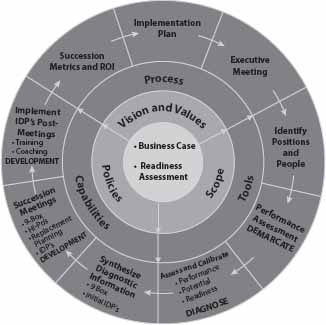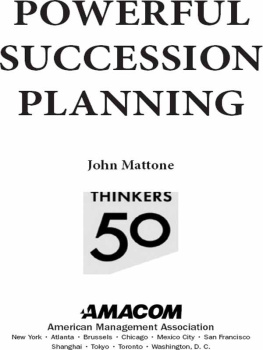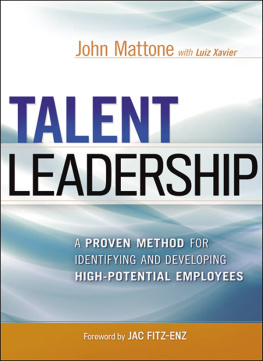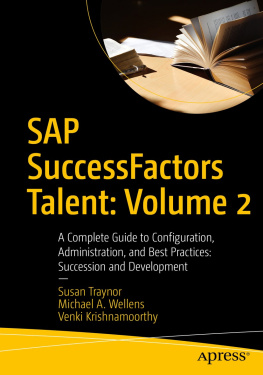Bulk discounts available. For details visit:
www.amacombooks.org/go/specialsales
Or contact special sales:
Phone: 800-250-5308
Email:
View all the AMACOM titles at: www.amacombooks.org
This publication is designed to provide accurate and authoritative information in regard to the subject matter covered. It is sold with the understanding that the publisher is not engaged in rendering legal, accounting, or other professional service. If legal advice or other expert assistance is required, the services of a competent professional person should be sought.
Library of Congress Cataloging-in-Publication Data
Mattone, John.
Powerful succession planning / John Mattone.
p. cm.
Includes bibliographical references and index.
ISBN 978-0-8144-3272-3
1. Executive successionPlanning. 2. Career development. 3. Business planning.
4. Project management. I. Title.
HD38.2.M38 2013
658.402dc23
2012022136
2013 John Mattone.
All rights reserved.
Printed in the United States of America.
This publication may not be reproduced, stored in a retrieval system, or transmitted in whole or in part, in any form or by any means, electronic, mechanical, photocopying, recording, or otherwise, without the prior written permission of AMACOM, a division of American Management Association, 1601 Broadway, New York, NY 10019.
The scanning, uploading, or distribution of this book via the Internet or any other means without the express permission of the publisher is illegal and punishable by law. Please purchase only authorized electronic editions of this work and do not participate in or encourage piracy of copyrighted materials, electronically or otherwise. Your support of the author's rights is appreciated.
About AMA
American Management Association (www.amanet.org) is a world leader in talent development, advancing the skills of individuals to drive business success. Our mission is to support the goals of individuals and organizations through a complete range of products and services, including classroom and virtual seminars, webcasts, webinars, podcasts, conferences, corporate and government solutions, business books and research. AMA's approach to improving performance combines experiential learninglearning through doingwith opportunities for ongoing professional growth at every step of one's career journey.
Printing number
10 9 8 7 6 5 4 3 2 1
What Is Succession Planning and Management?
William Rothwell, author of the book Effective Succession Planning, defines succession planning as any effort designed to ensure the continued effective performance of an organization, division, department, or work group by making provision for the development, replacement, and strategic application of key people over time. In essence, succession planning is about identifying and developing your best talent (present and future) and preparing these individuals to assume higher-level roles or other key positions in the organization.
Succession Planning and Management can be interpreted as an organization's intelligent approach to dealing with the loss of key talent that it may be experiencing now, as well as the inevitable loss of talent projected to occur in the future (based on workforce plans). Organizations with intelligent succession plans have created contingencies for successfully combating their present and future losses. Organizations without succession plans have no choice but to react to the inevitable losses they encounter with panic and reactivity, which results in ineffective succession decisions.
Why Is Succession Planning and Management Needed?
In today's challenging economy, leaders at all levels are facing enormous challenges when it comes to achieving and sustaining breakthrough operating results. Globalization, economic change, more stringent regulation, and tougher governance make realizing shareholder value increasingly difficult. But, there is another challenge: identifying and developing high-potential and emerging leaders is (and will continue to be) one of the top business issues facing CEOs, as 40 to 70 percent of all current executives in most organizations will become eligible for retirement in the next five years.
In our increasingly knowledge-driven economy, organizations are right to fear this brain drain, suspecting that when executives leave their firms, the business may follow. Yet high-potentialsthose people most likely to rise to fill those highest positionsaccount for less than 8 to 10 percent of the talent pool. So, identifying, developing, and retaining such rare talent is a mission-critical challenge for CEOs, senior executives, managers, and HR directors. One thing is sure: the retention of key talentfor every organizationis no longer a nice to have. All talentespecially Gen X'ers and Gen Y'erswants challenging work and exciting opportunity, as well as transparency and equitable treatment. A succession plan provides a clear roadmap for achieving these objectives.
Important Findings
Research findings support the importance of succession planning. Our own 2011 global research study and report (Executive Development Associates, Executive Trends Survey), which I co-authored with Bonnie Hagemann, identified the top priority for organizations, regardless of sector, industry, or geography: the need to increase bench strength. This finding was also the number-one priority noted in our 2009 study. The second prioritythe need to accelerate the development of high-potentials and emerging leadersclearly is related to building bench strength. Given the rapid environmental changes that organizations face, and the large number of people reaching retirement age, accelerating the development of high-potential and emerging-leader talent pools becomes vital.
As the number of key positions eventually becomes greater than the number of ready now candidates available, offering accelerated development grows even more critical as a means for attracting and retaining talent. Organizations that fail to offer such opportunities will lose talent, as quality people gravitate to organizations that offer such opportunities.
JMP's Succession Management Map
The JMP Succession Management Map () is a model that can help guide succession planning and management, and indeed, it has been a guiding framework for several organizations. The inner core of the model depicts the macro succession-management processes: identifying the vision and values of a succession planning and management system, determining the scope of that system, and creating the policies that support succession management. The outer core of the model depicts the specific micro succession-management steps and processes that result from the macro processes of the inner core.
Exhibit 1. JMP's Succession Management Map.

The Nuts & Bolts of Implementing a Succession Planning and Management Program
STEP 1: Project Planning Meeting
The first step in initiating a talent-assessment and succession-management effort is to strategically and tactically plan for the effort. Assembling the key stakeholders for a project kick-off and planning meeting is essential for the effort to be successful. One of the key purposes of the meeting is to build support among all stakeholders; without such support, the project may be delayed, derailed, or abandoned. To build support, all stakeholders must help identify the purpose and scope of the project. With involvement of the key stakeholders at the beginning, there is less likelihood that a particular person, workgroup, or division will resist the efforts later on. Hammering out disagreements early in the process will save a lot of time and money, and will avoid much anguish later in the process.














